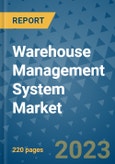The global warehouse management system (WMS) market is experiencing a surge in demand due to the need for effective management of end-to-end routine operations at warehouses. The rise of 5G technology is expected to be a vital driving factor for the market as it improves speed, connectivity, and dependability, making cloud-based warehouse management software more accessible and efficient.
Key Report Findings
The global warehouse management system market size was approximately US$3 Bn in 2022. Cloud-based WMS solutions remain sought-after. The e-Commerce industry and third-party logistics (3PL) space will be major contributors to market growth. Asia Pacific displays impressive growth potential. Top industry players include Microsoft, IBM, Oracle, Blue Yonder, and SAP.Growth Drivers
Warehouse management systems offer several advantages, including improved real-time inventory visibility, operational efficiency, cost reduction, waste volume reduction, and effective labor management. These benefits drive the global demand for WMS as more brands strive for better supply chain management and customer relationships.Splendid e-Commerce Expansion
The robust growth of the e-Commerce industry directly influences WMS adoption as brands seek to improve accuracy in store-level inventory and broaden order and fulfillment options. This leads to the need for conventional warehouse reconfigurations, especially in the retail sector, where the focus is on e-Commerce. In-store warehouse management solutions gain significance, thereby boosting revenue in the WMS market.Growing Digitalization of Supply Chain Networks
The rapid digitalization of supply chain ecosystems fortifies market growth, particularly with the increasing demand for cloud-based WMS solutions across industries. The market benefits from the unprecedented growth of the e-Commerce industry and the proliferation of multi-channel distribution networks.Pandemic a Game Changer for Logistics
The COVID-19 pandemic has revolutionized the logistics and warehousing sectors, accelerating the need for efficient logistical and warehouse management processes. The increasing volume of e-Commerce sales and the shortage of warehouse labor further elevate the demand for WMS solutions.Mounting Demand for Cloud-based WMS Solutions
Businesses are increasingly adopting cloud WMS solutions for optimal inventory and supply chain management. The lower costs, scalability, faster implementation, and reduced maintenance of cloud-based solutions drive their preference over traditional on-premises WMS.Growth Challenges
High initial capital investments associated with setting up on-premises WMS, especially for small- and mid-sized organizations, pose a challenge to the market's long-term growth. Concerns about the safety and security of sensitive information and data privacy also limit the expansion of the market.Overview of Key Segments
WMS adoption is concentrated among 3PL logistics vendors, e-Commerce fulfillment centers, and large-scale distributors. Almost every industry vertical today employs a WMS for its perceived benefits. The Asia Pacific region is anticipated to witness faster adoption of WMS due to the rapid expansion of the e-Commerce industry.Growth Opportunities Across Regions
North America and Europe dominate the market, attributed to early adoption of warehouse automation technologies and a strong presence of 3PL networks. Asia Pacific reflects high growth potential, driven by the high-growth economies of India, China, and the Philippines.Key Players in Warehouse Management System Market
Leading vendors in the warehouse management system market include Microsoft, IBM, Oracle, Blue Yonder, SAP, Körber Supply Chain, and Synergy Logistics. Other significant players include Click Reply, Infor, Honeywell International Inc., Zebra Technologies, and Manhattan Associates.Table of Contents
1. Executive Summary
2. Market Overview
3. Global Warehouse Management System Market Outlook, 2018-2030
4. North America Warehouse Management System Market Outlook, 2018-2030
5. Europe Warehouse Management System Market Outlook, 2018-2030
6. Asia Pacific Warehouse Management System Market Outlook, 2018-2030
7. Latin America Warehouse Management System Market Outlook, 2018 - 2030
8. Middle East & Africa Warehouse Management System Market Outlook, 2018-2030
9. Competitive Landscape
10. Appendix
Companies Mentioned
- Blue Yonder
- Oracle Corporation
- SAP SE
- Fishbowl Invetory
- Acumatica
- Körber AG
- Logiwa Technology, Inc.
- Infor
- Epicor Software Corporation
- Manhattan Associates
- Softeon
- Microsoft Corporation
- Mantis
Methodology

LOADING...








